木制品熏蒸要求(澳大利亚)
- 格式:doc
- 大小:86.00 KB
- 文档页数:13
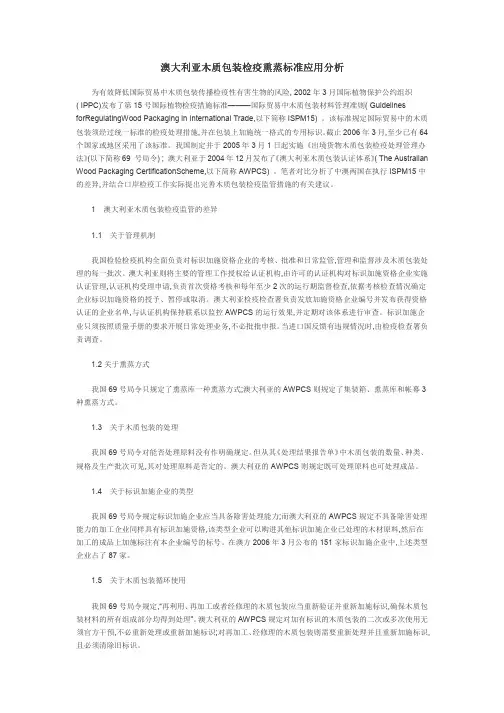
澳大利亚木质包装检疫熏蒸标准应用分析为有效降低国际贸易中木质包装传播检疫性有害生物的风险, 2002年3月国际植物保护公约组织( IPPC)发布了第15号国际植物检疫措施标准———国际贸易中木质包装材料管理准则( Guidelines forRegulatingWood Packaging in International Trade,以下简称ISPM15) 。
该标准规定国际贸易中的木质包装须经过统一标准的检疫处理措施,并在包装上加施统一格式的专用标识。
截止2006年3月,至少已有64个国家或地区采用了该标准。
我国制定并于2005年3月1日起实施《出境货物木质包装检疫处理管理办法》(以下简称69 号局令) ; 澳大利亚于2004年12月发布了《澳大利亚木质包装认证体系》( The Australian Wood Packaging CertificationScheme,以下简称AWPCS) 。
笔者对比分析了中澳两国在执行ISPM15中的差异,并结合口岸检疫工作实际提出完善木质包装检疫监管措施的有关建议。
1澳大利亚木质包装检疫监管的差异1.1关于管理机制我国检验检疫机构全面负责对标识加施资格企业的考核、批准和日常监管,管理和监督涉及木质包装处理的每一批次。
澳大利亚则将主要的管理工作授权给认证机构,由许可的认证机构对标识加施资格企业实施认证管理,认证机构受理申请,负责首次资格考核和每年至少2次的运行期监督检查,依据考核检查情况确定企业标识加施资格的授予、暂停或取消。
澳大利亚检疫检查署负责发放加施资格企业编号并发布获得资格认证的企业名单,与认证机构保持联系以监控AWPCS的运行效果,并定期对该体系进行审查。
标识加施企业只须按照质量手册的要求开展日常处理业务,不必批批申报。
当进口国反馈有违规情况时,由检疫检查署负责调查。
1.2关于熏蒸方式我国69号局令只规定了熏蒸库一种熏蒸方式;澳大利亚的AWPCS则规定了集装箱、熏蒸库和帐幕3种熏蒸方式。

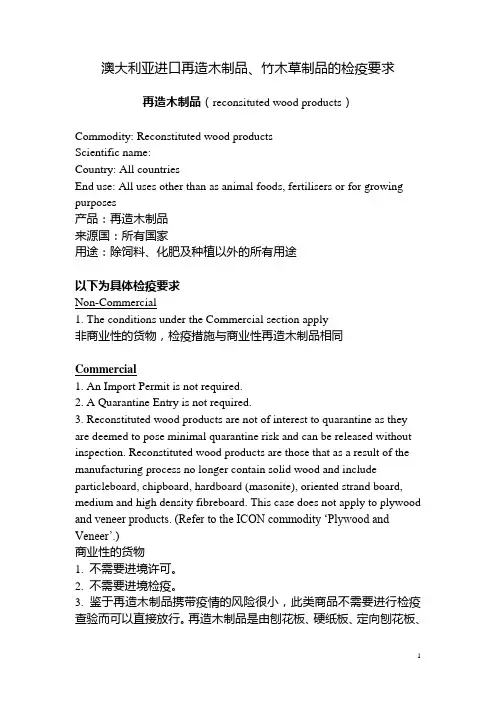
澳大利亚进口再造木制品、竹木草制品的检疫要求再造木制品(reconsituted wood products)Commodity: Reconstituted wood productsScientific name:Country: All countriesEnd use: All uses other than as animal foods, fertilisers or for growing purposes产品:再造木制品来源国:所有国家用途:除饲料、化肥及种植以外的所有用途以下为具体检疫要求Non-Commercial1. The conditions under the Commercial section apply非商业性的货物,检疫措施与商业性再造木制品相同Commercial1. An Import Permit is not required.2. A Quarantine Entry is not required.3. Reconstituted wood products are not of interest to quarantine as they are deemed to pose minimal quarantine risk and can be released without inspection. Reconstituted wood products are those that as a result of the manufacturing process no longer contain solid wood and include particleboard, chipboard, hardboard (masonite), oriented strand board, medium and high density fibreboard. This case does not apply to plywood and veneer products. (Refer to the ICON commodity ‘Plywood and Veneer’.)商业性的货物1. 不需要进境许可。
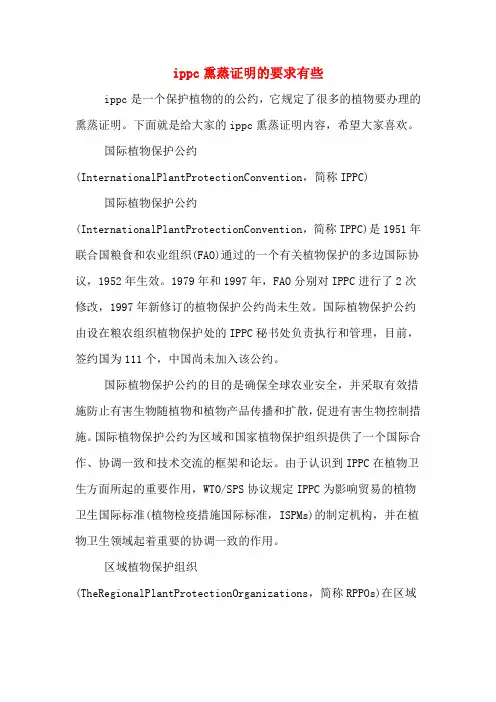
ippc熏蒸证明的要求有些ippc是一个保护植物的的公约,它规定了很多的植物要办理的熏蒸证明。
下面就是给大家的ippc熏蒸证明内容,希望大家喜欢。
国际植物保护公约(InternationalPlantProtectionConvention,简称IPPC) 国际植物保护公约(InternationalPlantProtectionConvention,简称IPPC)是1951年联合国粮食和农业组织(FAO)通过的一个有关植物保护的多边国际协议,1952年生效。
1979年和1997年,FAO分别对IPPC进行了2次修改,1997年新修订的植物保护公约尚未生效。
国际植物保护公约由设在粮农组织植物保护处的IPPC秘书处负责执行和管理,目前,签约国为111个,中国尚未加入该公约。
国际植物保护公约的目的是确保全球农业安全,并采取有效措施防止有害生物随植物和植物产品传播和扩散,促进有害生物控制措施。
国际植物保护公约为区域和国家植物保护组织提供了一个国际合作、协调一致和技术交流的框架和论坛。
由于认识到IPPC在植物卫生方面所起的重要作用,WTO/SPS协议规定IPPC为影响贸易的植物卫生国际标准(植物检疫措施国际标准,ISPMs)的制定机构,并在植物卫生领域起着重要的协调一致的作用。
区域植物保护组织(TheRegionalPlantProtectionOrganizations,简称RPPOs)在区域范围内负责协调有关IPPC的活动,在新修订的IPPC中,区域性植物保护组织的作用扩展到与IPPC秘书处一起协调工作。
根据各个国家的情况不同,对熏蒸证明的提供也有所不同。
特别是在全球最大的交易网站eBay上做对外贸易卖家而言,更需要提供熏蒸证明。
此外提供熏蒸证明,需要注意一些事项。
熏蒸证明书是用于证明出口粮谷、油籽、豆类、皮张等商品,以及包装用木材与植物性填充物等,已经过熏蒸灭虫的证书。
对于做出口贸易的卖家而言,当出口的商品将一些需要熏蒸证明的相关物品销往国外时,外贸企业需要提供熏蒸证明书,这是对商品的保障。

澳大利亚溴甲烷熏蒸标准澳大利亚溴甲烷熏蒸标准是指对于澳洲各类跨国物流出口产品的溴甲烷熏蒸进行规范的标准。
在出口产品过程中,对于可能携带有害生物,如蚂蚱、白蚁等的木包装材料,使用溴甲烷熏蒸是常见的一种消毒方法。
为避免熏蒸方法对环境及人类的危害,澳大利亚严格执行溴甲烷熏蒸标准,以下是相关内容。
一、熏蒸要求:1.熏蒸拥有资质的熏蒸公司按照标准程序进行熏蒸,并进行监管,确保环境与人体健康不受影响。
2.加热溴甲烷至沸腾后,放置待温度降低并搅动溶液、再次升温的过程重复数次,确保产品周围的溴甲烷分布均匀。
3.以单位面积内浓度≥56g/m2.h的规定时间进行熏蒸,以保证有效性,保持熏蒸浓度的稳定。
二、熏蒸要求的安全措施:1.责任方须进行相关员工的安全训练,使用必须全程佩戴安全手套、口罩等防护器材,以保证人体健康安全问题。
2.标准下,熏蒸环境应该相对封闭,并开放足够的通风或者保持相对低温度。
3.必须规划必要的泄漏和废料处置计划,以确保对环境的影响降至最小。
三、熏蒸操作和修正:1.在熏徐过程中,一旦出现明显泄漏气体,要及时调整仪器,确保熏蒸环境的稳定。
2.如果出现熏蒸浓度偏低的情况,熏蒸时间必须延长到足够的浓度长度,以确保消毒效果。
3.每次使用后,设备都必须彻底清洁和消毒,以避免残留和交叉感染问题。
澳大利亚溴甲烷熏蒸标准是出口产品物流中的必备程序。
在熏蒸活动中,必须严格控制环境和人体健康方面的安全问题,确保熏蒸效果。
熏蒸过程需要保持周遭的均匀分布;同时需要对管道、熏蒸设备进行适当调整,以保证操作的安全性。
在每次完成使用后,需要对设备进行彻底的清洁和消毒,为次次熏蒸工作做好准备工作。

关于出口木质包装(熏蒸)第一篇:关于出口木质包装(熏蒸)关于出口木质包装(熏蒸)标签:资料一:目前,对我国出口货物木质包装要求进行检疫或检疫处理合格,并出具相关检疫证书的输入国有:澳大利亚、新西兰、美国、加拿大、巴西和欧盟(奥地利、比利时、丹麦、芬兰、法国、德国、希腊、爱尔兰、意大利、卢森堡、荷兰、葡萄牙、西班牙、瑞典、英国成员国)。
具体要求如下:(一)、澳大利亚、新西兰的检疫要求出口货物的木质包装在中国出境前经检疫处理的,须提供中国官方出具的《熏蒸/消毒证书》,方可入境;在中国出境前未能取得中国官方出具的《熏蒸/消毒证书》的,该批货物木质包装也可以在输入国口岸的检疫部门监督下,拆除木包装进行处理,或连同货物一并处理。
因此,这类货物木质包装在出口前是否向检验检疫机构申报检疫处理由出口企业自行决定。
(二)、美国、加拿大、巴西的检疫要求1、出口货物使用木质包装的,必须在中国出境前经检疫处理,并取得中国官方出具的《熏蒸/消毒证书》,方可入境;否则,将被退货、或其他检疫处理。
2、出口货物未使用木质包装的,出口企业可以自行出具无木质包装证明或在装箱单、提单、发票上注明该批货物无木质包装声明,便可入境。
(三)、欧盟的检疫要求1、1999年6月10日起实施的紧急法令(简称1号法令):“木质包装不得带有树皮,不能有直径大于3毫米的虫蛀洞;或者必须对木质包装进行烘干处理,使木材含水量低于20%”。
由于该法令未要求出具官方检疫证书,因此,只要出口企业所使用的木质包装符合上述标准,便可直接出口。
但是,在入境时被输入国检疫部门抽查发现所使用的木质包装不符合上述标准的,将被退货或其他检疫处理。
为了出口货物在输入国顺利通关,出口企业认为所使用的木包装不符合上述要求的,可向检验检疫机构申请检疫处理并出具《熏蒸/消毒证书》。
2、2001年10月1日起实施的对针叶树木质包装紧急法令(简称2号法令):(1)出口欧盟货物使用松材线虫疫区针叶树木质包装的,在出口前须进行热处理,处理合格的木质包装上须有标记,在标记上注明处理方法、地点及实施处理的单位,并由出入境检验检疫机构出具《植物检疫证书》。
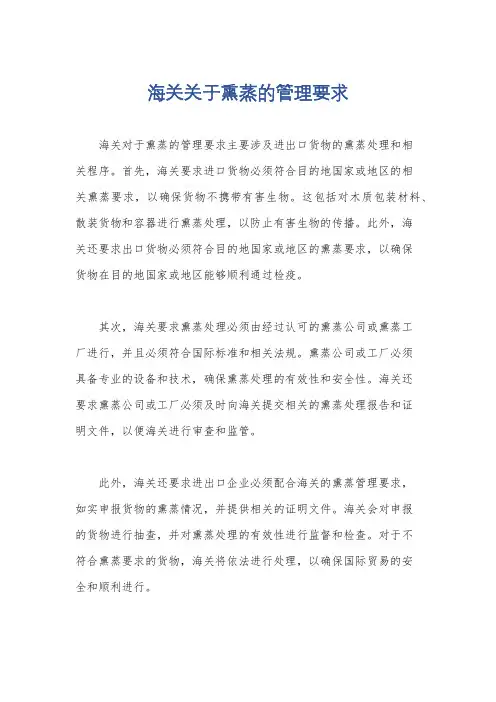
海关关于熏蒸的管理要求
海关对于熏蒸的管理要求主要涉及进出口货物的熏蒸处理和相
关程序。
首先,海关要求进口货物必须符合目的地国家或地区的相
关熏蒸要求,以确保货物不携带有害生物。
这包括对木质包装材料、散装货物和容器进行熏蒸处理,以防止有害生物的传播。
此外,海
关还要求出口货物必须符合目的地国家或地区的熏蒸要求,以确保
货物在目的地国家或地区能够顺利通过检疫。
其次,海关要求熏蒸处理必须由经过认可的熏蒸公司或熏蒸工
厂进行,并且必须符合国际标准和相关法规。
熏蒸公司或工厂必须
具备专业的设备和技术,确保熏蒸处理的有效性和安全性。
海关还
要求熏蒸公司或工厂必须及时向海关提交相关的熏蒸处理报告和证
明文件,以便海关进行审查和监管。
此外,海关还要求进出口企业必须配合海关的熏蒸管理要求,
如实申报货物的熏蒸情况,并提供相关的证明文件。
海关会对申报
的货物进行抽查,并对熏蒸处理的有效性进行监督和检查。
对于不
符合熏蒸要求的货物,海关将依法进行处理,以确保国际贸易的安
全和顺利进行。
总的来说,海关对于熏蒸的管理要求主要是为了防止有害生物的传播,保障国际贸易的安全和顺利进行。
企业和熏蒸公司必须严格遵守相关要求,配合海关的监管和检查工作,确保货物的熏蒸处理符合法规,以免遭受不必要的损失和延误。
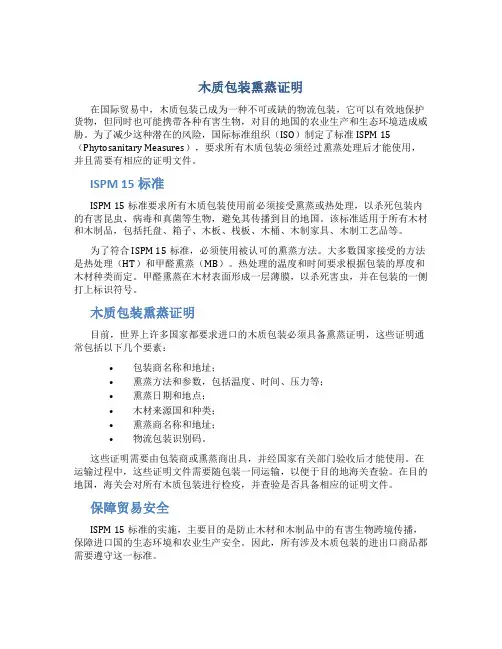
木质包装熏蒸证明在国际贸易中,木质包装已成为一种不可或缺的物流包装,它可以有效地保护货物,但同时也可能携带各种有害生物,对目的地国的农业生产和生态环境造成威胁。
为了减少这种潜在的风险,国际标准组织(ISO)制定了标准ISPM 15(Phytosanitary Measures),要求所有木质包装必须经过熏蒸处理后才能使用,并且需要有相应的证明文件。
ISPM 15标准ISPM 15标准要求所有木质包装使用前必须接受熏蒸或热处理,以杀死包装内的有害昆虫、病毒和真菌等生物,避免其传播到目的地国。
该标准适用于所有木材和木制品,包括托盘、箱子、木板、栈板、木桶、木制家具、木制工艺品等。
为了符合ISPM 15标准,必须使用被认可的熏蒸方法。
大多数国家接受的方法是热处理(HT)和甲醛熏蒸(MB)。
热处理的温度和时间要求根据包装的厚度和木材种类而定。
甲醛熏蒸在木材表面形成一层薄膜,以杀死害虫,并在包装的一侧打上标识符号。
木质包装熏蒸证明目前,世界上许多国家都要求进口的木质包装必须具备熏蒸证明,这些证明通常包括以下几个要素:•包装商名称和地址;•熏蒸方法和参数,包括温度、时间、压力等;•熏蒸日期和地点;•木材来源国和种类;•熏蒸商名称和地址;•物流包装识别码。
这些证明需要由包装商或熏蒸商出具,并经国家有关部门验收后才能使用。
在运输过程中,这些证明文件需要随包装一同运输,以便于目的地海关查验。
在目的地国,海关会对所有木质包装进行检疫,并查验是否具备相应的证明文件。
保障贸易安全ISPM 15标准的实施,主要目的是防止木材和木制品中的有害生物跨境传播,保障进口国的生态环境和农业生产安全。
因此,所有涉及木质包装的进出口商品都需要遵守这一标准。
除了符合国际标准之外,良好的包装也是保障贸易安全的重要一环。
我们需要选择高质量的包装材料、专业的包装方案,以减少货物在运输中的损失和风险。
Packaging Design Solutions公司致力于为客户提供全方位、专业的国际物流包装方案,帮助客户保障贸易安全,降低运输成本,提高运输效率。
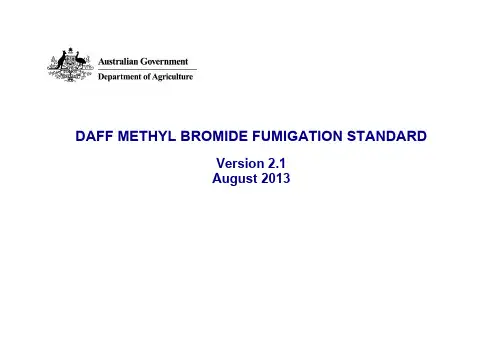
DAFF METHYL BROMIDE FUMIGATION STANDARDVersion 2.1August 2013CONTENTSFumigant considerations – risk assessment, commodity, dosage, temperature (5)1.1 Risk assessment (5)1.2 Commodity (Non perishable) (5)1.3 Commodity (Perishable) (5)1.4 Dosage (6)1.5 Temperature (7)The fumigation site (8)2.1 Site requirements (8)2.2 Site floor (8)Consignment suitability for fumigation (9)3.1 Fumigant circulation (9)3.2 Fumigant penetration (10)The fumigation enclosure (11)4.1 Chamber fumigation (12)4.2 Pressure tested container (13)4.3 Un-sheeted container (14)4.4 Sheeted enclosures (15)4.5 Safety (16)Preparing the fumigation enclosure (17)5.1 Monitoring tubes (17)5.2 Fumigant supply pipes (18)5.3 Fans (19)5.4 Sand and water snake specifications (19)Calculating the dosage of fumigant required (20)6.1 Calculation of fumigation enclosure volume (20)6.2 Calculation of fumigant dosage (20)Performing the fumigation (21)7.1 Using a vaporiser (21)7.2 Distributing fumigant within the enclosure (22)7.3 Checking for leaks (22)Monitoring and maintaining fumigant concentrations (23)8.1 Monitoring frequency (23)8.2 Fumigant levels – Start-point and End-point (24)8.3 Fumigant concentrations (25)8.4 Topping-up (27)Completing the fumigation (28)9.1 Ventilation (28)9.1 Continued (29)9.2 Certification (29)APPENDIX 1: Fumigation of Perishable Commodities (30)APPENDIX 2: Fumigation of vessels with methyl bromide (32)APPENDIX 3: Commodities for which problems may occur when fumigated withmethyl bromide (39)APPENDIX 4: Example of a record of fumigation (40)APPENDIX 5: Example of a fumigation certificate (41)APPENDIX 6: Pressure testing chambers and containers for gas-tightness (43)Page 2APPENDIX 7: Monitor tube placement for container fumigation (46)APPENDIX 8: Fumigant gas supply pipe systems (47)APPENDIX 9: Calculating the volume of differently shaped fumigation enclosures .. 48APPENDIX 10: Vaporisers for methyl bromide (49)APPENDIX 11: Methyl bromide monitoring table (51)APPENDIX 12: Examples of ‘Top-up’ calculations (53)APPENDIX 13: Methyl bromide as a quarantine fumigant (55)APPENDIX 14: Methyl bromide as an ozone depleting gas (56)APPENDIX 15: Glossary of terms (57)Page 3How to use this Standard This standard is divided into two main sections:∙DAFF Requirements∙Descriptive AppendicesDAFF RequirementsDAFF requirements for this section are designed to be subject to audit during quality control procedures, either by DAFF, by other quarantine authorities or by authorised agents of either.This section is divided into two main columns:MANDATORYThis column lists conditions that MUST be achieved and actions which MUST be undertaken in order to conform to the requirements of the DAFF Standard.INFORMATIVEThis column lists information that may be helpful to a fumigator in achieving the Mandatory Requirement.AppendicesThese appendices provide information on a range of issues that may be helpful to a fumigator on various aspects of the fumigation procedure.MANDATORY INFORMATIVE FUMIGANT CONSIDERATIONS – RISK ASSESSMENT, COMMODITY, DOSAGE, TEMPERATURE 1.1 Risk assessment1.1.1 Before commencing anyfumigation process a riskassessment must be carried out. The purpose of risk assessments is to ensure that any fumigation undertaken is carried out in such a way that minimises any Workplace Health and Safety (WH&S) risks, meets local regulations, protects the local population and the environment,and addresses potential adverse effects on the commodity being fumigated. A risk assessment may be written or visual, as appropriate1.2 C ommodity (Non perishable)1.2.1 The commodity must be suitablefor methyl bromide fumigation. See the Import Conditions (ICON) database.au/biosecurity/import/icon-icd for information on specific commodities.Some commodities are unsuited to this treatment as they absorb large quantitiesof methyl bromide e.g oils, fats and finely ground materials. This may causetainting or phyto-toxicity and may lead to hazards such as the presence ofexcessive bromide residues. This may result in the fumigated commodity notbeing suitable for its intended use.If there is concern that a commodity may be adversely affected by methylbromide, importers, exporters and fumigators should seek expert advice (outsideof DAFF) regarding its effects or conduct tests on the commodity.See APPENDIX 3: Commodities for which problems may occur whenfumigated with methyl bromide. This table lists some commodities for whichexperts have found problems when fumigated with methyl bromide. This list isnot comprehensive and is provided for guidance only.1.3 Commodity (Perishable)1.3.1 Fumigation of nursery stockmust only be performed inAustralia.1.3.2 Fumigation of fresh flowers mustonly be performed in Australia(unless exemptions are in place).Perishable commodities include cut flowers, fresh fruit, vegetables and nursery stock.Additional requirements for the fumigation of perishable goods are set out in APPENDIX 1: Fumigation of perishable commoditiesMANDATORY INFORMATIVE 1.4 Dosage1.4.1Dosage must conform to:∙Permit conditions to importQuarantine Material intoAustralia;∙DAFF Import Conditions(ICON) database;∙Quarantine Directions (within Australia). Overdosing (the application of fumigant at rates above those specified by DAFF) to compensate for poor fumigation practice or inadequate equipment or sheeting should not be undertaken.See the ICON database (.au/biosecurity/import/icon-icd)1.4.2 For the majority of commodities(excluding perishables) DAFFtreatment dosages must be basedon the anticipated minimumambient temperature that thecommodities inside thefumigation enclosure willexperience during the fumigationperiod.TABLE 1 :COMMON STANDARD DOSAGEFOR METHYL BROMIDE FUMIGATIONPEST/COMMODITYREQUIREDCONCENTRATIONGiant African Snail128g/m³ at 21 °C for 24 hours atNormal Atmospheric Pressure(NAP)Khapra Beetle80 g/m³ for 48 hours with aminimum concentration of24 g/m³ after 24 hours at NAP Other Stored Product Pests of Quarantineconcern32 g/m³ at 21 ºC for 24 hours atNAPTimber48 g/m³ at 21 °C for 24 hours atNAPMANDATORY INFORMATIVE 1.5 Temperature1.5.1 Fumigation for quarantinepurposes is not permitted if theambient minimum temperaturefalls below 10 °C. At temperatures below 10 °C the fumigant has decreased effectiveness against pests, and more of the gas may be absorbed by the commodity. Excessive fumigant uptake can pose an increased safety risk, as the gas is difficult to remove from the commodity.1.5.2 Dosage must be compensated fortemperatures below 21 °C. For each 5°C (or part of 5°C) the temperatureis expected to fall below 21 °C, 8g/m³ must beadded to the dosage, unless otherwisespecified by DAFF.For example, using the standard dosage of48g/m³ for a 24 hour exposure period, thedosage at:21 °C and above is 48 g/m316 – 20 °C is 56 g/m311 – 15 °C is 64 g/m310 °C is 72 g/m3The fumigation provider must record thetemperature information on the fumigationcertificate.Minimum ambient temperatureThe minimum ambient temperature that the fumigation enclosure is expectedto experience over the duration of the treatment should be determined bychecking with the official weather bureau in the country where the fumigation istaking place. This temperature should be used when determining the dosage.Alternatively, temperature recording equipment may be used to verify thetemperature within the enclosure during the fumigation exposure period.See APPENDIX 5: Example of a fumigation certificate.1.5.3 Heating of fumigationenclosures. The temperature in the fumigation enclosuremust be raised above 10 °C during fumigationif the minimum temperature inside theenclosure is expected to fall below 10 °C.Heaters incorporating a fan and thermostat may be used for this purpose. Flashproof heaters should be used if the commodity is flammable.Consideration can also be given to storing and fumigating the commodity inheated warehouses during extended cold periods.MANDATORY INFORMATIVE THE FUMIGATION SITE2.1 Site requirements2.1.1 The fumigation site must:∙Be able to be isolated fromunprotected personnel.∙Be well ventilated.∙Be sheltered from high winds (as much as possible).∙Have a power supply available (either mains or generator). The site should be protected from adverse weather conditions such as high winds that can affect fumigation performance.Electrical power or a generator will need to be accessible on site to run fans and heaters during fumigation treatments.2.2 Site floor2.2.1 The fumigation floor must be flatand even.2.2.2 The fumigation site floor must beimpermeable to the fumigant forsheeted containers and stacks. The floor of any site used for fumigationsperformed under sheets must be:∙Free of stones and other sharp objects sothat a gas-tight seal can be made betweenthe sheets and the floor;∙Free of cracks (including unsealedexpansion joints in concrete floors) anddrains or any other openings that willreduce the gas tightness of the enclosure.Where unsealed cracks or drains are present,they must be no closer than 1 metre from thefumigation enclosure.Uneven surfaces for fumigations performed in containers can cause the containeritself to flex making it difficult to get a good seal and prevent excessive leakageof the fumigant.Surfaces sealed with concrete or hot mix asphalt, that is, with a smooth surfacefinish that are in good condition and meet the requirements listed to the left,generally provide good floor surfaces for effective sheet fumigation.Where unsealed cracks exist in a floor intended for fumigation, they may besealed with an impervious sealant.Surfaces such as soil (including cement consolidated soil), sand, base rock andpaving (stones or blocks) do not provide a suitable floor for a sheet fumigationenclosure.∙On porous or unsuitable surfaces gas proof sheets should be used or the floorshould be permanently sealed;∙Plastic sheeting or paper containing a tar (asphalt) layer may be used for thispurpose.MANDATORY INFORMATIVE CONSIGNMENT SUITABILITY FOR FUMIGATION3.1 Fumigant circulation3.1.1 There must be sufficient free airspace to circulate the fumigant andachieve uniform distributionthroughout the enclosure.The fumigator must be able to demonstratethat the required concentration of methylbromide can reach the target of thefumigation by taking and recordingconcentration readings from representativepoints within the enclosure.See 5.1 Monitoring tubes and,7.2 Distributing fumigant within theenclosureThe free air space requirements for effective treatment of a consignment will varydepending on the commodity and the method of packing.As a guide, there should be at least 350 mm of free airspace in total with 200 mmfree air space above the commodity, 50 mm below and the remaining 100 mm atthe sides and between the commodities.Where commodities are stacked on the floor there must be sufficient free airspace between individual items to allow the fumigant to act effectively on thetarget of the fumigation throughout the entire enclosure.If there is insufficient space to allow the monitoring tubes to be positionedaccording to the requirements then it is unlikely that the consignment can befumigated effectively.3.1.2 Timber must be separated by aminimum of 5 mm of air space inone dimension every 200 mm. The separators must allow for any sagging to ensure that the 5 mm minimum separation is maintained along the entire length of the timber.MANDATORY INFORMATIVE 3.2 Fumigant penetration3.2.1 The target of the fumigation mustnot be wrapped in or coated withmaterials that are impervious tomethyl bromide. The fumigator must verify that theconsignment is not wrapped in imperviousmaterials that may prevent the methylbromide from reaching the target of thefumigation.The fumigator must verify that the target ofthe fumigation does not have impervioussurfaces or coatings such as paints, lacquersand veneers that may prevent the effectivepenetration of methyl bromide.Impervious wrappings such as plastic, tarredor waxed papers, aluminium foil etc. mustbe perforated, cut or removed prior tofumigation to allow the methyl bromide toreach the target of the fumigation.If the consignment cannot be fully inspected for impervious materials because ofproblems with accessibility the fumigator can;∙Rely on a packing declaration from the supplier/shipper/ packer thatdescribes how the consignment is packaged and what packing materialshave been used that allows assessment of the consignment‟s suitabilityfor fumigation.Or, if this documentation is not available;∙Contact another party that has sufficient knowledge of the consignmentto obtain a written declaration that states that it is free from impervioussurfaces or wrappings that would prevent an effective fumigation.If suitable declarations cannot be obtained the container should be unpacked forinspection prior to fumigation. The inspection must be conducted either by thefumigator or by another party that subsequently provides the fumigator with awritten declaration indicating that it is free from impervious surfaces orwrappings.Impervious wrapping does not need to becut or removed prior to fumigation if itconforms to the DAFF wrapping andperforation standard and is not more thanone layer thick.The DAFF Wrapping and Perforation StandardTo meet DAFF perforation requirements for fumigation impervious materialsmust contain not less than four (4) perforations of 6 mm diameter / 100 cm2(10 cm x 10 cm square) or five (5) perforations of 5 mm diameter / 100 cm2.Plastic wraps containing numerous pinholes (at least 6 holes / cm2), frequentlyused for transportation of fruit and vegetables are also acceptable.3.2.2 Untreated timber products musthave at least one physicaldimension which is less than 200mm thick. Timber products must be fumigated beforeany surface coating such as lacquering orpaint is applied unless the product has atleast one uncoated surface and a maximumthickness of 100 mm from the uncoatedsurface.Methyl bromide will, in general, only penetrate 100 mm from the surface intotimber within the fumigation exposure period.MANDATORYINFORMATIVETHE FUMIGATION ENCLOSUREFUMIGATION TREATMENTS FOR QUARANTINE PURPOSES MUST BE CARRIED OUT IN GAS-TIGHT ENCLOSURESThere are several types of enclosures that are suitable for quarantine fumigations of cargo. This diagram illustrates the possible fumigation enclosure options.FumigatePassFailFumigateFumigateFumigateChamber (see 4.1)Pressure Tested Container(see 4.2)Sheeted Enclosure(One or more containers or free standing goods fumigated under an impervious sheet (see 4.4)Un-sheeted Container(Seal container vents/door, bag container floors(see 4.3)Fumigation starting optionsMANDATORY INFORMATIVE 4.1 Chamber fumigation4.1.1 A fumigation can be performed ina permanent structure specificallydesigned for fumigation. Thisincludes shipping containers fixedin place and converted for thispurpose.4.1.2 A pressure decay time from 200 to100 Pa of 10 seconds or more mustbe achieved to verify that achamber is gas-tight.To satisfy these requirements, thefumigation chamber must:∙Be constructed from rigid materialson all sides including the door∙Be permanently sealed along alljoins between the walls, roof andfloor∙Be gas-tight once the door isclosed without the need to usetape, sealant, sand snakes or anyother means to ensure a gas tightseal.∙Not have anything enter thechamber through the door that willinterfere with the seal such asmonitor tubes, supply pipes orelectrical leads.∙Have an inbuilt circulation systemto adequately distribute thefumigant throughout the chamber.∙Have an inbuilt extraction systemthat actively removes the fumigantfrom the enclosure and vents it tothe open air above the roofline ordirects it for recapture; and∙Pass a pressure test at least every 6months.The following actions should occur before performing any chamber fumigation:∙Check that the chamber is not damaged and that there are no objects between thechamber and the chamber door to impair the seal;∙Visually inspect the door seals of the chamber and replace where necessaryIn addition to the pressure test results, deterioration in the ability of the chamber toretain fumigant can indicate the need for maintenance workSee APPENDIX 6: Pressure testing enclosures for gas-tightness.Stricter pressure test requirements are considered necessary for fumigation chambersbecause they are often located inside buildings and in close proximity to unprotectedpersonnel.MANDATORY INFORMATIVE 4.2 Pressure tested container4.2.1 A container can be used forfumigations without the need tosheet or seal the doors and base ofthe container if it passes a pressuretest.4.2.2 A pressure decay time from 50 to25 Pa of 5 seconds or more must beachieved to verify that a containeris gas-tight. If the decay time between 50 Pa and 25 Pa isless than 5 seconds, the container must beenclosed under a gas proof sheet or adequatelysealed (see un-sheeted container forrequirements) before being fumigated withmethyl bromide.Care must be taken to ensure that monitoringtubes, fumigant supply pipes and electricalcables introduced into a container after thepressure test, are adequately sealed to maintaina gas-tight condition.See APPENDIX 6: Pressure testing enclosures for gas-tightness.MANDATORY INFORMATIVE 4.3 Un-sheeted container4.3.1 A container can be used forfumigations without the need topressure test or enclose under agas-proof sheet provided thecontainer can be adequately sealedto ensure a gas tight enclosure. The container must be checked for any visibleholes/damage which may cause gas loss.Visible holes/damage must be repaired.All air vents must be sealed with tape or othersuitable means.The door seals and areas where the supplypipes and monitoring lines exit the containermust be carefully checked for leaks and sealedwith tape or other suitable means.A suitable barrier must be placed around theexternal base of the container up to the level ofthe floor to reduce the amount of air passingunderneath the container. (This is not requiredfor fumigations performed on skeletal trailers)If the fumigation is performed in a containeron a skeletal trailer the following additionalrequirements apply:∙The floor of the container must be leakchecked and any leaks must be adequatelysealed.∙The trailer must remain stationary for theduration of the fumigation and until safelyventilated to 5ppm or less.The container vents and doors can be sealed using tape and/or other suitablesealants. Pay particular attention to the front of the container where the leads andsupply pipes exit the container.Sand snakes can be used to create this barrier. Ensure sand snakes seal all gaps atthe base of the container to reduce the amount of air passing underneath.See 5.4 - Sand and water snake specificationsMANDATORY INFORMATIVE 4.4 Sheeted enclosures4.4.1 Containers and free-standing goodscan be fumigated under gas proofsheets.4.4.2 Prior to every treatment allfumigation sheets must be visuallyinspected for tears, holes andabrasions. These must be repaired orthe sheet replaced.4.4.3 The sheets must:∙Be free from any defects (for example faulty seams/welds, tears or holes);∙Have a permeability of less than 0.02 grams per square metre (offumigation sheet) per 24 hours(multiplied by the dose in g/m³).4.4.4 Sheets must be positioned to create agas-tight seal with the floor. For any sheet fumigation:∙Fumigation sheets must be positioned orprotected with suitable padding to avoid anysharp corners or objects that might damagethem;∙Sheets must be arranged so that there is at least500 mm of sheet extending beyond the limit ofthe seal;In high winds, ropes or belts must be used tohold fumigation sheets in place to preventthem from flapping loose.Joining fumigation sheetsFumigation sheets can be joined by tightly rolling a 400 mm to 500 mmoverlapped join, which should be secured by tight gripping welding styleclips.Joins should be made on, and supported by, a solid surface e.g. a containerroof or wall.When battens are used, there must be at least three to four full turns of thesheets around the battens and the rolled sheets must be held together withtight gripping clips.∙Corners and areas where ropes, electrical leads, gassing pipes andmonitoring tubes emerge from between or under the sheets must be tightlysealed;∙Loose fumigation sheeting on corners of stacks must be secured byfolding, rolling and clipping to prevent blowing out in the wind;∙Where one or more containers are being fumigated under a sheet, at leastone door of each container must be fully opened.Sand or water snakes used to seal the junction of fumigation sheets and thefloor must be overlapped and positioned to prevent fumigant leakage.See 5.4 Sand and water snake specificationsMANDATORY INFORMATIVE 4.5 Safety4.5.1 The fumigation enclosure andthe surrounding area must bemade safe for unprotectedpersonnel.4.5.2 A full-face respirator or self-contained breathing apparatusmust be used when releasingfumigant and while workingwithin the risk area after thefumigant has been released. A …risk area‟ must be set up with a minimum of 3metres clearance around the fumigation enclosure inthe open, or 6 metres clearance in an enclosed area, andwarning signs put in place. The area must be clearedof any unprotected personnel, that is, personnel notwearing a respirator, and at no time during thefumigation treatment should unprotected personnel beallowed to enter the …risk area‟.Respirators must be fitted with a correct gas cartridgeand specified by the manufacturer as suitable formethyl bromide (AX filter type).Gas filter canisters should be used and replaced in accordance with themanufacturer‟s instructions.MANDATORY INFORMATIVE PREPARING THE FUMIGATION ENCLOSURE5.1 Monitoring tubes5.1.1 All fumigations must bemonitored. For enclosures largerthan 30 cubic metres (equivalentto the average internal volume ofa 20 ft shipping container), aminimum of three monitoringtubes must be positioned withinthe enclosure.5.1.2 For enclosures smaller than 30cubic metres, a minimum of onemonitoring tube must be placedat the top centre of thecommodity being fumigated.5.1.3 For commodities not fumigatedinside a container (e.g. largeitems of industrial andagricultural machinery, baggedgrain, stacks of timber) the entireenclosed space within thefumigation sheets must betreated as a single fumigationenclosure. Monitoring tubes must be placed as far aspracticable from fumigant supply pipes.ONE container must have one monitoring tubeplaced:∙at the top back of the commodity– as farfrom the doors as possible;∙as close to the centre of the commodity as ispracticable;∙at the front base of the commodity.TWO containers (in the one enclosure) musthave one monitoring tube placed:∙at the top centre of the commodity in eachcontainer;∙at the front base of the commodity in eithercontainer.THREE containers or more (in the oneenclosure) must have one monitoring tubeplaced:∙at the top centre of the commodity in eachcontainer.See APPENDIX 7: Monitoring tube placementfor container fumigation.Monitoring tube inlets should be at least 2 metres from the outlet of fumigantsupply pipes.Before placing monitoring tubes inside an enclosure, ensure that:∙Each monitoring tube can be identified through the use of tags or individuallycoloured tubes.Fumigant monitoring tube specificationsCrush-proof nylon, hydraulic tubing or similar (The internal diameter must nosmaller than the internal diameter of the sampling probe of the concentrationmeasuring instrument) is effective for monitoring gas concentrations whencontainers and other enclosures are fumigated.Care should be taken to ensure that:∙The monitoring tubes do not absorb methyl bromide;∙ A free flow mixture of gas/air can be maintained;∙The monitoring tubes are joined to the sampling inlet of the measuringinstrument so that no fresh air is drawn in while the readings are being taken;∙No kinks or blockages are present in the tubes; and∙Monitoring tubes extend beyond the boundary of the risk area.MANDATORY INFORMATIVE 5.2 Fumigant supply pipes5.2.1 Fumigant supply pipes must bepositioned to allow the fumigantto be introduced into the free airspace around the commodity. Fumigant supply pipes must be placed as faras practicable from fumigant monitoringtubes.Monitoring tube inlets should be at least 2 metres from the outlet of fumigantsupply pipes.Sealing fumigant supply pipesTo prevent leakage from supply pipes:∙Make a gas-tight seal around every supply pipe exit point from the enclosure;∙Seal the exposed ends after the fumigant has been introduced into theenclosure.5.2.2 Multiple containers under theone enclosure must have afumigant supply pipe in eachcontainer. Where multiple fumigant supply pipe systemsare used, the entire system must be balancedin order to achieve even distributionthroughout the enclosure.In order to balance the system, each arm ofthe system must consist of fumigant supplypipes that are equal in total length anddiameter.Multiple fumigant supply pipes per enclosureThe use of multiple fumigant supply pipes will assist in distributing the fumigantwhen large enclosures or several containers in the one enclosure are treated.Where the system is balanced, it is possible to effectively deliver all of thefumigant through the entire system simultaneously.Where the system cannot be balanced, the correct amount of fumigant should bedispensed through each supply pipe in turn until the total amount of fumigant isapplied.See APPENDIX 8: Fumigant gas supply pipe systems.MANDATORY INFORMATIVE 5.3 Fans5.3.1 Fans must be positioned to ensurethat the fumigant is rapidly andeffectively distributed throughoutthe fumigation enclosure.5.3.2 For methyl bromide fumigationin small enclosures (such asfreight containers), at least onefan must be used. For fumigationin larger enclosures, at least twofans must be used.5.3.3 Where multiple containers arefumigated under the same sheets,fans must be placed in eachcontainer.The fans must be switched on 10-15 minutesbefore the gas is introduced and for 30 minutesafter the introduction of the methyl bromide, oruntil gas monitoring indicates that uniform gasdistribution has been achieved.Where high velocity and high volume fans are used, they should not run for longerthan necessary after the introduction of the fumigant, as they may force thefumigant out of the enclosure.Fans should have a capacity to make at least 20 air changes an hour, taking intoconsideration the volume of the enclosure5.4 Sand and water snake specifications5.4.1 When using sand snakes, aminimum of two rows of sandsnakes must be placed side byside with joins overlapping (likebrickwork), and laid flush againstthe enclosure to create acontinuous seal. Sand snakes must be filled to only 65% - 75%with sand so that they lie flat on the fumigationfloor.Additional sand snakes may be placed on corners and other areas where fumigantleakage may be higher due to folds in the sheet or the presence of pipes orelectrical leads.5.4.2 When using water snakes a single,continuous water snake must belaid flush against the enclosure tocreate a continuous seal. Water snakes must be filled to only 75% - 85%of capacity so that they lie flat on thefumigation floor.If water snakes are used, the sheets should be weighed down and sealed using asingle, continuous water snake placed flush against the enclosure. Particularattention should be given to ensure a complete seal where the ends of the watersnake meet. Water snake placement should not start or end on a corner.。
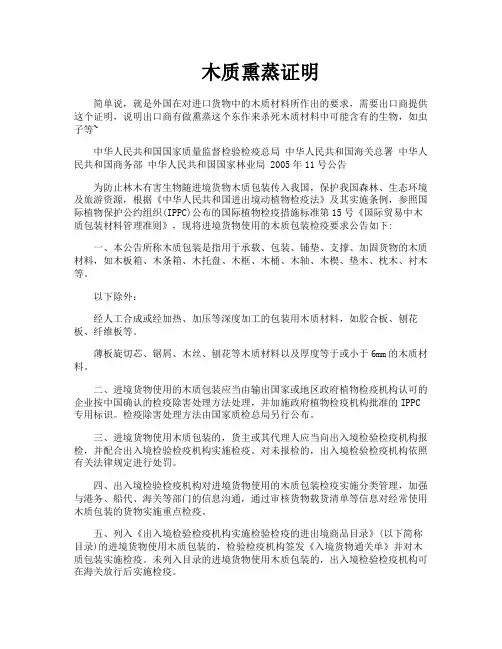
木质熏蒸证明简单说,就是外国在对进口货物中的木质材料所作出的要求,需要出口商提供这个证明,说明出口商有做熏蒸这个东作来杀死木质材料中可能含有的生物,如虫子等~中华人民共和国国家质量监督检验检疫总局中华人民共和国海关总署中华人民共和国商务部中华人民共和国国家林业局 2005年11号公告为防止林木有害生物随进境货物木质包装传入我国,保护我国森林、生态环境及旅游资源,根据《中华人民共和国进出境动植物检疫法》及其实施条例,参照国际植物保护公约组织(IPPC)公布的国际植物检疫措施标准第15号《国际贸易中木质包装材料管理准则》,现将进境货物使用的木质包装检疫要求公告如下:一、本公告所称木质包装是指用于承载、包装、铺垫、支撑、加固货物的木质材料,如木板箱、木条箱、木托盘、木框、木桶、木轴、木楔、垫木、枕木、衬木等。
以下除外:经人工合成或经加热、加压等深度加工的包装用木质材料,如胶合板、刨花板、纤维板等。
薄板旋切芯、锯屑、木丝、刨花等木质材料以及厚度等于或小于6mm的木质材料。
二、进境货物使用的木质包装应当由输出国家或地区政府植物检疫机构认可的企业按中国确认的检疫除害处理方法处理,并加施政府植物检疫机构批准的IPPC 专用标识。
检疫除害处理方法由国家质检总局另行公布。
三、进境货物使用木质包装的,货主或其代理人应当向出入境检验检疫机构报检,并配合出入境检验检疫机构实施检疫。
对未报检的,出入境检验检疫机构依照有关法律规定进行处罚。
四、出入境检验检疫机构对进境货物使用的木质包装检疫实施分类管理,加强与港务、船代、海关等部门的信息沟通,通过审核货物载货清单等信息对经常使用木质包装的货物实施重点检疫。
五、列入《出入境检验检疫机构实施检验检疫的进出境商品目录》(以下简称目录)的进境货物使用木质包装的,检验检疫机构签发《入境货物通关单》并对木质包装实施检疫。
未列入目录的进境货物使用木质包装的,出入境检验检疫机构可在海关放行后实施检疫。

澳大利亚进口再造木制品、竹木草制品的检疫要求再造木制品(reconsituted wood products)Commodity: Reconstituted wood productsScientific name:Country: All countriesEnd use: All uses other than as animal foods, fertilisers or for growing purposes产品:再造木制品来源国:所有国家用途:除饲料、化肥及种植以外的所有用途以下为具体检疫要求Non-Commercial1. The conditions under the Commercial section apply非商业性的货物,检疫措施与商业性再造木制品相同Commercial1. An Import Permit is not required.2. A Quarantine Entry is not required.3. Reconstituted wood products are not of interest to quarantine as they are deemed to pose minimal quarantine risk and can be released without inspection. Reconstituted wood products are those that as a result of the manufacturing process no longer contain solid wood and include particleboard, chipboard, hardboard (masonite), oriented strand board, medium and high density fibreboard. This case does not apply to plywood and veneer products. (Refer to the ICON commodity …Plywood and Veneer?.)商业性的货物1. 不需要进境许可。
书山有路勤为径;学海无涯苦作舟
澳大利亚木质包装材料检疫规则
澳大利亚是世界森林大国。
为了加强对森林病虫害的预防,确保本国森林资源的安全,同样对进口货物的木质包装材料制定了适合本国森林品种的检疫制度。
因它具体的检疫规则和要求几乎包含了世界各国规定的检疫内容,因而为许多国家所借鉴引用,现介绍如下:
1、检疫的品种和害虫
主要是针对木质包装材料中的黄几或胡蜂类害虫。
2、灭虫消毒的方法、标准和要求
(1)臭甲烷熏蒸。
具体规定如下:
温度(℃)剂量(克/立方米)熏蒸时间
21.0以上48 24
16.0以上56 24
11.0以上64 24
6.0以上48 24
1.0以上48 24
澳大利亚政府又规定,自2000年9月1日起对10℃以下的臭甲烷熏蒸效果不予认可。
(2)热处理
首先要对木材进行干热处理,使之水分含量达到12%以下,然后再进行74℃以上的湿热处理。
对不同厚度木材的热处理时间为:
木材厚度热处理时间
25mm以下4hr
50mm以下6hr
专注下一代成长,为了孩子。
熏蒸操作流程及熏蒸的原因熏蒸程序2007-07-03 14:05凡木质包装且出口至加拿大、美国、澳大利亚等国或客户要求做熏蒸的货物,均需做熏蒸。
其程序如下:1.报检:1)备材料:报检委托书、清单、发票。
2)打单、预录入、并取回报检单和工作联系单。
2.预约:1)第一次预约:持报检单提前半个工作日到东渡商检局植检处预约、登记。
2)第二次预约:持工作联系单到植检处预约当天上午(或下午)熏蒸事宜,并告知地点及联系电话。
3.熏蒸:1)植检人员开箱检查。
主要内容有:柜子严实否,通气孔是否封死,木质包装物是否有树皮、蛀虫孔、检测木质包装物温度,核对件数、唛头、品名、登记柜号。
2)封箱、充气。
熏蒸时间为24小时。
3)充气后的柜子不可移动。
4.放气:熏蒸24小时后,由植检人员开箱放气。
一般放气半个工作日后才可关箱、上封铅与拖进港区码头。
5.打通关单:放气后半个工作日,凭工作联系单打通关单(通关单主要用于报关)。
6.取熏蒸证明书:凭工作联系单取证书,一般放气后三个工作日即可领取。
7.将熏蒸证明书送客户,并收回所代垫的熏蒸费用(具体由公司财务部门安排收款)。
8.熏蒸前应注意事项:1)落实柜子所停放的位置。
2)检查柜子是否有破洞、破损等。
3)封死柜子的通气孔。
4)柜门是否能关闭严实。
木质包装的包装物必须无树皮、无蛀虫孔等。
熏蒸费用东港报关行1. 商检局固定收费: RMB600/20’, RMB850/40’&40’HQ2. 预录入: RMB30/票3. 商检手续费: RMB16/票4. 加盖商检标识费: RMB50/票5. 报关行收取代理费:岛内: RMB100/票海沧: RMB150/票6. 进海沧码头内做熏蒸, 另加集装箱搬移费: RMB159/20’.7. 岛内拖装加收租用场地费: RMB150/20’, RMB200/40’&40’HQ8. 海沧拖装与进海沧码头内做熏蒸收费一样。
场装费用(单位: RMB)堆场20’ 40’&40’HQ乾坤元车场(轻抛货) 525 925海天裕利625 1025胜狮655 1125三得利575 1075海投 5 55 1025海沧裕雄555 1025一、木质包装熏蒸的目的和意义在国际贸易中,各国为保护本国的资源,对有的进口商品实行强制的检疫制度。
澳大利亚进口再造木制品、竹木草制品的检疫要求再造木制品(reconsituted wood products)Commodity: Reconstituted wood productsScientific name:Country: All countriesEnd use: All uses other than as animal foods, fertilisers or for growing purposes产品:再造木制品来源国:所有国家用途:除饲料、化肥及种植以外的所有用途以下为具体检疫要求Non-Commercial1. The conditions under the Commercial section apply非商业性的货物,检疫措施与商业性再造木制品相同Commercial1. An Import Permit is not required.2. A Quarantine Entry is not required.3. Reconstituted wood products are not of interest to quarantine as they are deemed to pose minimal quarantine risk and can be released without inspection. Reconstituted wood products are those that as a result of the manufacturing process no longer contain solid wood and include particleboard, chipboard, hardboard (masonite), oriented strand board, medium and high densityfibreboard. This case does not apply to plywood and veneer products. (Refer to the ICON commodity ‘Plywood and Veneer’.)商业性的货物1. 不需要进境许可。
关于出口货物熏蒸的要求和程序(一)熏蒸可以分为整箱熏蒸和拼箱熏蒸整箱熏蒸:1.不需要加“IPPC”标识,货到场地后直接装箱,通知熏蒸队进行熏蒸,按目的国的不同喷洒不同刻度的熏蒸药剂,分为CH3BR、PH3,如客户无特殊要求,熏蒸队喷洒CH3BR药剂,进行24小时熏蒸。
2.需要加“IPPC”标识:货送到场地后先落到场地,通知报关行货物落地的位置,熏蒸队会在每个包装的前面和后面施加“IPPC”字样,然后安排场地装箱。
然后进行熏蒸。
3.对包装进行熏蒸:向海关递报检的单据做商检,然后专门对包装进行熏蒸。
拼箱熏蒸:对于拼箱货物的熏蒸可以放到同一个集装箱里做熏蒸,但是必须同时满足一下四个条件:1.同一个目的港 2.同一个国家 3.同一个航次 4.在同一个商检局报检(二)熏蒸的一些要求 1.熏蒸时间:熏蒸必须达到24小时,熏蒸后熏蒸队在柜门上施加有骷髅标志的熏蒸标识。
24小时后,熏蒸队将标标识取下,散毒需要4小时,然后才可以安排入港。
若散毒时间不够就将柜门关上可能会到货物造成损害。
目前大连共有三支熏蒸队在场地工作,工作比较多,故熏蒸最好提前两天时间比较保险,对于出口需商检的货,货最晚也得在船期截载时间前的两天送到场地。
2.对包装的要求:木质包装不能有树皮和虫眼。
如果木质包装有树皮,一般报关行会帮助客户将树皮铲掉;如发现有虫眼,则需要通知发货人更换包装。
熏蒸后如要求出熏蒸证,为目的港进口清关所用,货走后不可以补。
(建议客户都出此证)。
1)标签内容IPPC即国际植物保护公约组织.根据我国国家质量监督检验检疫总局2005年第4号公告通知,自2005年3月1日输往欧盟、美国、加拿大、澳大利亚等国家的带木质包装的货物,其木质包装要加盖IPPC的专用标识。
(胶合板、刨花板、纤维板等除外) 2)填写完熏蒸联系单,待检疫人员签字后,方可熏蒸,否则熏蒸队不给作熏蒸。
3)熏蒸药剂:CH3BR (一般情况下)4)填写报检单时,若货要加标识,填在“备注”里。
输澳大利亚货物常规熏蒸及澳大利亚检验检疫局溴甲烷熏蒸标准培训班本培训课程内容是根据澳大利亚检验检疫局熏蒸标准的要求,专门提供给拥有经验的熏蒸人员课程目的向拥有经验的熏蒸人员介绍澳大利亚检验检疫局溴甲烷熏蒸标准指出符合澳大利亚检验检疫局标准的熏蒸处理要求和程序在本课程结束时,您将明确理解与澳大利亚检验检疫局标准有关的熏蒸原则和做法,并能演示实施如下活动:您将掌握如下选择正确的个人防护设备挑选工作所需的恰当的设备和材料决定针对一个商品所需要的熏蒸方法监测熏蒸剂水平以确保熏蒸成功您将能够确保准备好商品做熏蒸建立熏蒸的密闭空间安全地施加气体准确地监测气体水平安全地从密闭空间调节排放气体您将能够胜任了解熏蒸剂作用过程对付不同商品和有害生物计算剂量和施用药剂时间确保实施正确的熏蒸程序确定熏蒸是否成功熏蒸原则基础知识熏蒸剂是什么?2476-1981澳大利亚检验检疫局标准“是一种化学剂,在特定的温度和压力下,能够处于气体状态,在足够浓度和足够时间下能够对昆虫或其他动物、杂草或其他有害生物起灭活作用”熏蒸剂如何起作用通过昆虫呼吸系统――通过表皮、护膜它越快呼吸就越快死亡――温度、湿度、二氧化碳溴甲烷熏蒸的特性良好的穿透能力作用迅速对许多种类的具有检疫意义的昆虫和其他有害生物产生高度毒效溴甲烷具体比重:3.27(空气:1)沸点:3.6℃气味-在低浓度时无气味不能燃烧通过压力瓶罐以液体的形式提供是有机物体的强大的溶解物液态溴甲烷与铝和镁产生反应溴甲烷的健康危害所有熏蒸人员都应了解中央、州或地方的关于如何使用溴甲烷的法规所有熏蒸人员都应了解溴甲烷的健康危害,并必须确保能够保护他们自己和他人而不被中毒。
溴甲烷中毒途径有如下情况,溴甲烷毒性就产生影响:吸如溴甲烷与皮肤或眼睛接触吞咽中毒症状也许拖延8-24小时后出现积极性中毒溴甲烷中毒症状眩晕说话含混不清头疼恶心呕吐视力模糊丧失食欲疲劳腹痛步行踉跄溴甲烷临界值(TLV)临界值是熏蒸人员在工作场所反复接触熏蒸剂而不受不良影响的极限浓度。
单*熏蒸和托盘基础理论知识在*贸易中,木材是应用十分广泛的商品包装材料之一,但使用木质包装也存在很大缺点,那就是出口国的有害生物附着在木质包装上随商品一起进入了进口国。
解决方法就是熏蒸那么,下面是由yjbys小编为大家分享单*熏蒸和托盘基础理论知识,欢迎大家阅读浏览。
一、货代中的熏蒸是什么意思?经常看到托运人给货代公司传真来的托运单写着货物需要熏蒸,熏蒸到底是什么意思,如果需要熏蒸的话是不是要在物流堆场进行呢?理解(一)在*贸易中,木材是应用十分广泛的商品包装材料之一,但使用木质包装也存在很大缺点,那就是出口国的有害生物附着在木质包装上随商品一起进入了进口国。
解决方法就是熏蒸。
关于处理措施,准则中已批准热处理和溴**熏蒸两种可采取的方法。
热处理,即根据特定时间—温度安排加热,这种安排实现木芯最低温度56℃及至少30分钟。
窑中烘干(KD)、化学加压浸透(CPI)或其它处理方法只要符合热处理规范则可视为热处理。
例如,化学加压浸透通过利用蒸汽、热水或干热,可能符合热处理规范。
热处理以HS标记表明。
对木质包装的溴**处理标准为最低温度不应低于10℃,最低熏蒸时间应为16小时,溴**处理以MB标记表明。
其标准如下:关于处置方式,是指输入国的国家植保机构在木质包装材料抵达时,在处理不能进行或者不理想的情况下可以采用的一种风险管理办法。
包括全部焚烧、深深埋藏、削成碎片和进一步加工或输入国植保机构赞同的对于有害生物有效的方法。
采用这些方法时尽可能不延误。
我国的《出境货物木质包装检疫处理管理办法》于2005年1月10日正式公布。
在木质包装材料范围、除害处理方法、加贴专用标识等方面都采用*标准。
在新办法中,对实施除害处理并加施标识的木质包装生产企业做出了明确的规定。
按照新的管理办法,木质包装生产企业须经直属检验检疫机构考核合格后获得除害处理标识加施资格,检验检疫机构对除害处理过程和加施标识情况实施监督管理。
处理结果经检验检疫机构认定除害处理合格后,标识加施企业按照规定加施标识。
澳大利亚进口再造木制品、竹木草制品的检疫要求再造木制品(reconsituted wood products)Commodity: Reconstituted wood productsScientific name:Country: All countriesEnd use: All uses other than as animal foods, fertilisers or for growing purposes产品:再造木制品来源国:所有国家用途:除饲料、化肥及种植以外的所有用途以下为具体检疫要求Non-Commercial1. The conditions under the Commercial section apply非商业性的货物,检疫措施与商业性再造木制品相同Commercial1. An Import Permit is not required.2. A Quarantine Entry is not required.3. Reconstituted wood products are not of interest to quarantine as they are deemed to pose minimal quarantine risk and can be released without inspection. Reconstituted wood products are those that as a result of the manufacturing process no longer contain solid wood and include particleboard, chipboard, hardboard (masonite), oriented strand board, medium and high density fibreboard. This case does not apply to plywood and veneer products. (Refer to the ICON commodity …Plywood and Veneer‟.)商业性的货物1. 不需要进境许可。
2. 不需要进境检疫。
3. 鉴于再造木制品携带疫情的风险很小,此类商品不需要进行检疫查验而可以直接放行。
再造木制品是由刨花板、硬纸板、定向刨花板、中密度及高密度纤维板等加工而成的不含天然木成份的产品,但不包括胶合板制品(具体参见ICON“胶合板”的检疫条件)。
胶合板检疫要求C8920Condition C8920Non-Commercial1. An Import Permit is not required.2. A Quarantine Entry is not required.3. Each consignment will be subject to an inspection to verify that it is free of live insects, bark and other quarantine risk material.4. If the consignment does not meet the above conditions it will require treatment as detailed in the Commercial conditions below, re-exportation or destruction.非商业性的货物1.不需要进境许可。
2.不需要进境检疫。
3.每批货物均须核查是否带有活昆虫、树皮或其他检疫风险物。
4.若不符合以上条件,必须按以下商业性货物的处理方法进行处理、退运或销毁。
Commercial1. An Import Permit is not required.2. A Quarantine Entry must be lodged for each consignment.3. Each consignment must be free of live insects, bark and other quarantine risk material prior to arrival in Australia.4. Any packaging used with the consignment must be clean and new.5. Containers, timber packing, pallets or dunnage associated with the consignment will be subject to inspection and treatment on arrival, unless certified as having been treated by an AQIS approved method (refer to the AQIS publication …Cargo Containers: Quarantine aspects and procedures‟).6. If the consignment is from a Giant African Snail target area the conditions in C8890 also apply. For a list of Giant African Snail target areas, please refer to the ICON commodity Snails - giant African snail (GAS).7. Consignments from countries other than Indonesia, Malaysia, Philippines, Thailand, Singapore, Fiji, Western Samoa and Vanuatu may be released if accompanied by a valid manufacturer‟s declaration (refer to Condition C10521) stating that:…The (name of plywood or veneer) in this consignment was manufactured in (name of country) on (date of manufacture) and has not been pre-used.‟The date of manufacture must be within 90 days of shipment.8. FCL and LCL consignments treated offshore which are accompanied by a valid treatment certificate may be released on presentation of documents. Acceptable treatments are:a) methyl bromide # (T9047, T9075 or T9913) (refer to C5154 below);b) sulphuryl fluoride # (T9090);c) kiln heat treatment # (T9912);d) heat treatment # (T9968);e) ethylene oxide (T9020) (refer to C9741 below) orf) permanent timber preservative treatment (T9987).# Treatments a)-d) must be completed within 21 days of export.9. Consignments that are not accompanied by an acceptable manufacturer‟s declaration or treatment certificate are subject to either:a) a full unpack and inspection at a Quarantine approved premises orb) a verification inspection prior to treatment at the importer‟s expen se. The treatment options are:· methyl bromide (T9047, T9075 or T9913) (refer to C5154);· kiln heat treatment (T9912);· ethylene oxide (T9020);· heat treatment (T9968) or· gamma irradiation (T9924).10. If live insects are found during the inspection they will be identified by an AQIS entomologist and the entire line/mark/consignment will be treated with methyl bromide fumigation (T9047, T9075 or T9913).11. If other contaminants such as soil or giant African snails are found on inspection, then the consignment must be held and the contaminants removed or treated by an AQIS approved method (if possible), or the consignment must be re-exported or destroyed at the importer‟s expense. Note: The Australian Pesticide and Veterinary Medicines Authority (APVMA) regulate ethylene oxide residues and may limit use on commodities that have direct contact with human skin. For information to determine if this treatment option is available for the commodity of import refer to the APVMA website.商业性的货物1. 不需要进境许可。